
Navy Interdiction Korea Vol. II
Rear Adm. Combs
PDF Version [34.9MB]
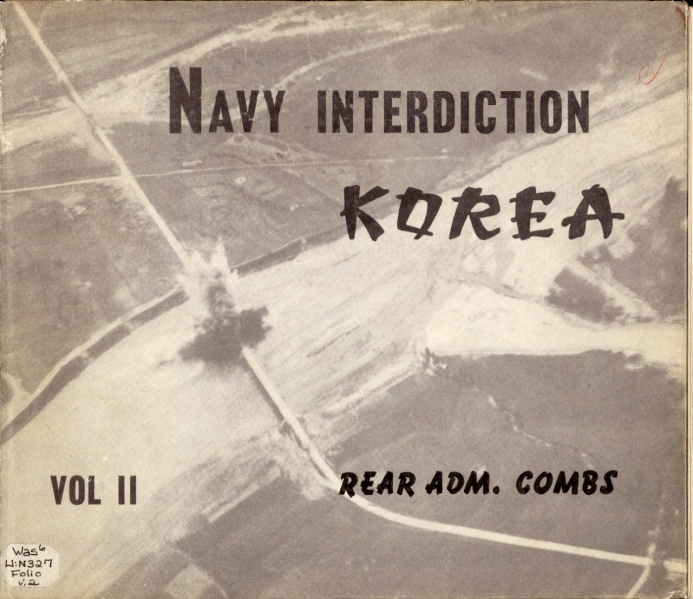
Navy Interdiction Korea VOL II
Rear Adm. Combs
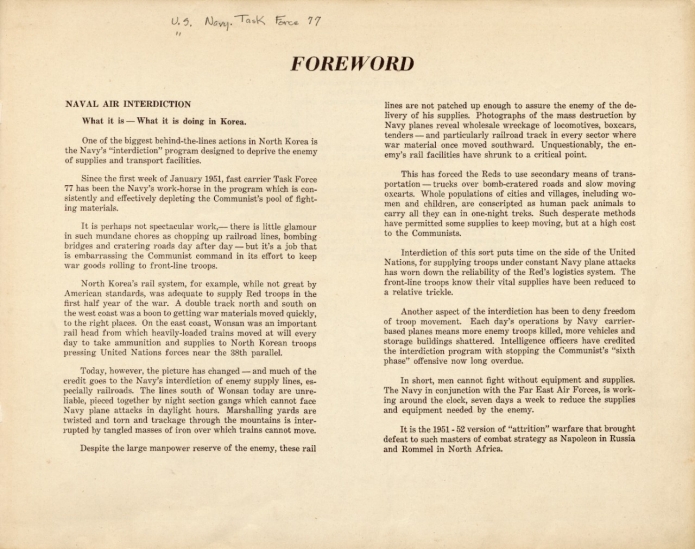
FOREWARD
NAVAL AIR INTERDICTION
What it is – What it is doing in Korea.
One of the biggest behind-the-lines actions in North Korea is the Navy’s “interdiction” program designed to deprive the enemy of supplies and transport facilities.
Since the first week of January 1951, fast carrier Task Force 77 has been the Navy’s work-horse in the program which is consistently and effectively depleting the Communist’s pool of fighting materials.
It is perhaps not spectacular work, – there is little glamour in such mundane chores as chopping up railroad lines, bombing bridges and cratering roads day after day – but it’s a job that is embarrassing the Communist command in its effort to keep war goods rolling to front-line troops.
North Korea’s rail system, for example, while not great by American standards, was adequate to supply Red troops in the first half year of the war. A double track north and south on the west coast was a boon to getting war materials moved quickly, to the right places. On the east coast, Wonsan was an important rail head from which heavily-loaded trains moved at will every day to take ammunition and supplies to North Korean troops pressing United Nations forces near the 38th parallel.
Today, however, the picture has changed – and much of the credit goes to the Navy’s interdiction of enemy supply lines, especially railroads. The lines south of Wonsan today are unreliable, pieced together by night section gangs which cannot face Navy plan attacks in daylight hours. Marshalling yards are twisted and torn and trackage through the mountains in interrupted by tangled masses of iron over which trains cannot move.
Despite the larger manpower reserve of the enemy, these rail lines are not patched up enough to assure the enemy of the delivery of his supplies. Photographs of the mass destruction by Navy plans reveal wholesale wreckage of locomotives, boxcars, tenders – and particularly railroad track in every sector where war material once moved southward. Unquestionably, the enemy’s rail facilities have shrunk to a critical point.
This has forced the Reds to use secondary means of transportation – trucks over bomb-cratered roads and slow moving oxcarts. Whole populations of cities and villages, including women and children, are conscripted as human pack animals to carry all they can in one-night treks. Such desperate methods have permitted some supplies to keep moving, but at a high cost to the Communists.
Interdiction of this sort puts time on the side of the United Nations, for supplying troops under constant Navy plane attacks has worn down the reliability of the Red’s logistics system. The front-line troops know their vital supplies have been reduced to a relative trickle.
Another aspect of the interdiction has been to deny freedom of troop movement. Each day’s operations by Navy carrier-based planes means more enemy troops killed more vehicles and storage buildings shattered. Intelligence officers have credited the interdiction program with stopping the Communist’s “sixth phase” offensive now long overdue.
In short, men cannot fight without equipment and supplies. The Navy in conjunction with the Far East Air Forces, is working around the clock, seven days a week to reduce the supplies and equipment needed by the enemy.
It is the 1951-52 version of “attrition” warfare that brought defeat to such masters of combat strategy as Napoleon in Russia and Rommel in North Africa.
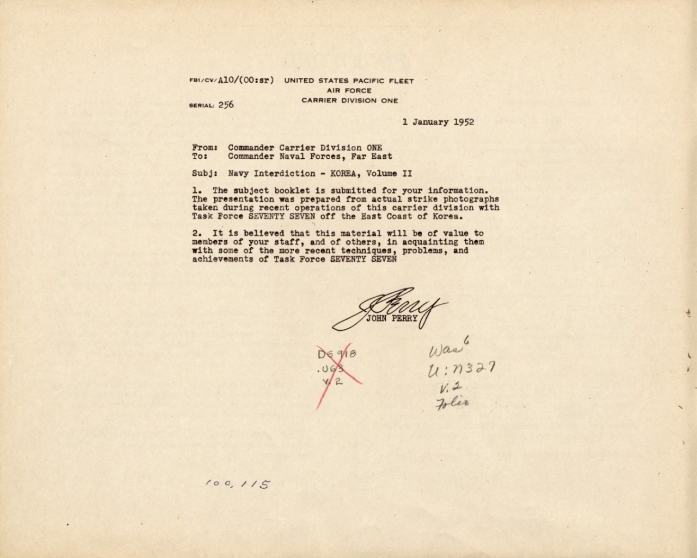
FB1/CV/A10/(00:sr)
United States Pacific Fleet
Air Force
Carrier Division One
Serial: 256
1 January 1952
From: Commander Carrier Division ONE
To: Commander Naval Forces, Far East
Subj: Navy Interdiction – Korea, Volume II
1. The subject booklet is submitted for your information. The presentation was prepared from actual strike photographs taken during recent operations of this carrier division with Task Force SEVENTY SEVEN off the East Coast of Korea.
2. It is believed that his material will be of value to members of your staff, and of others, in acquainting them with some of the more recent techniques, problems, and achievements of Task Force SEVENTY SEVEN
John Perry
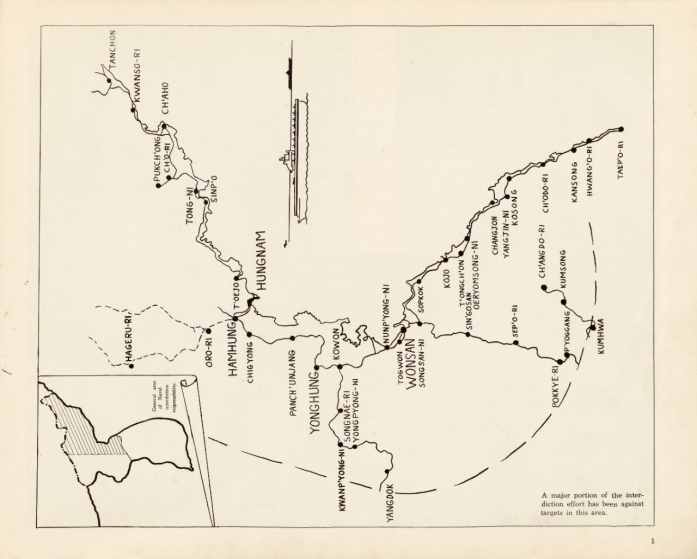
General areas of Naval interdiction responsibility.
A major portion of the interdiction effort has been against targets in this area.
--1--
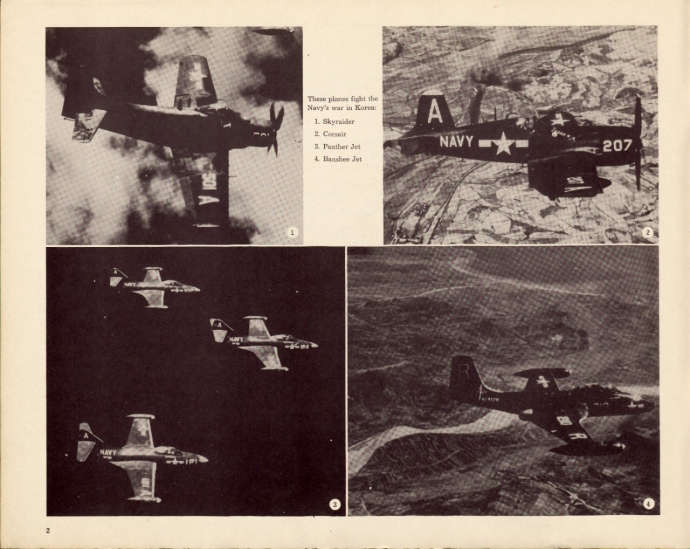
These planes fight the Navy’s war in Korea:
1. Skyraider
2. Corsair
3. Panther Jet
4. Banshee Jet
--2--
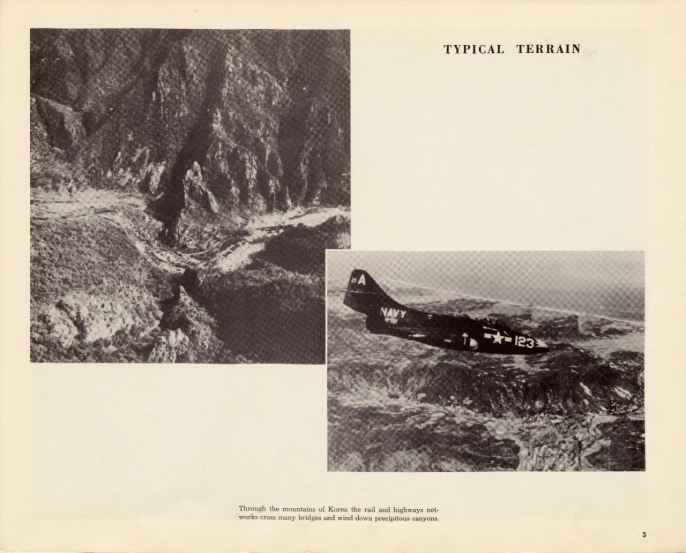
Typical Terrain
Through the mountains of Korea the rail and highways networks cross many bridges and wind down precipitous canyons.
--3--
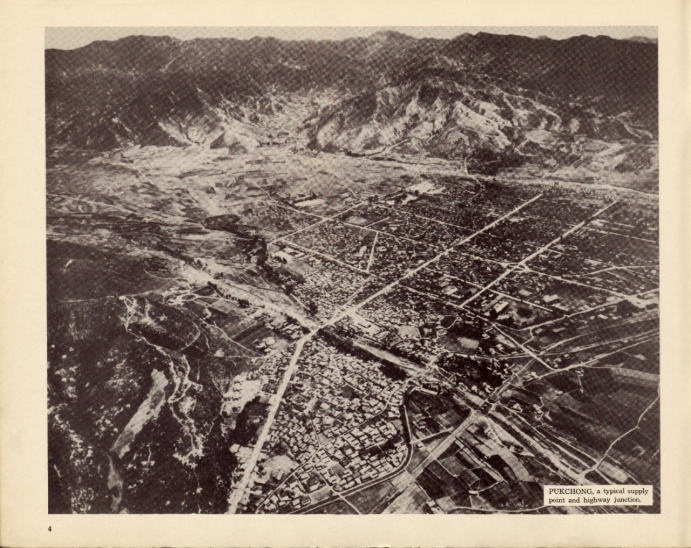
Pukchong, a typical supply point and highway junction.
--4--
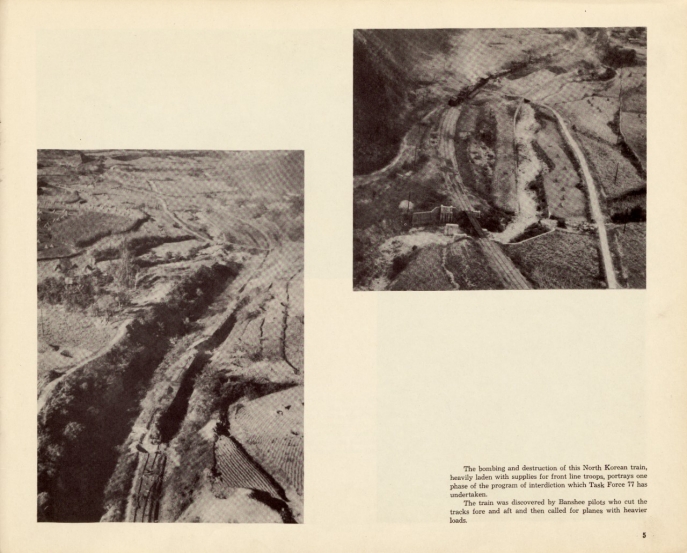
The bombing and destruction of this North Korea train, heavily laden with supplies for the front line troops, portrays one phase of the program of interdiction which Task Force 77 has undertaken.
The train was discovered by Banshee pilots who cut the tracks fore and aft and then called for planes with heavier loads.
--5--
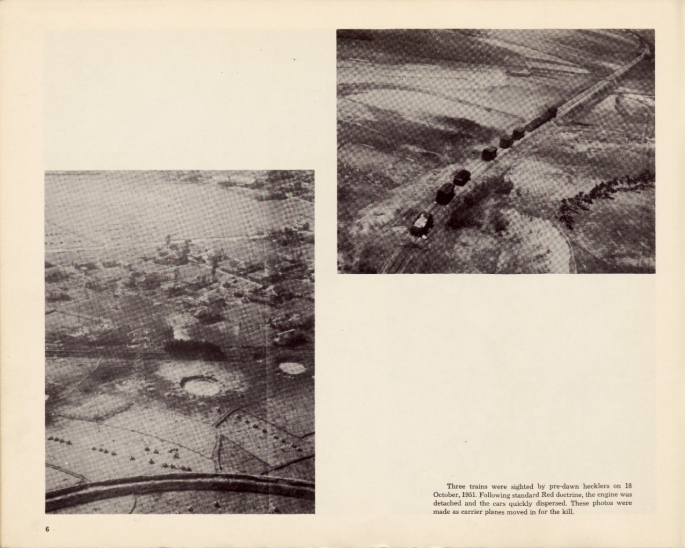
Three trains were sighted by pre-down hecklers on 18 October, 1951. Following standard Red doctrine, the engine was detached and the cars quickly dispersed. These photos were made as carrier planes moved in for the kill.
--6--
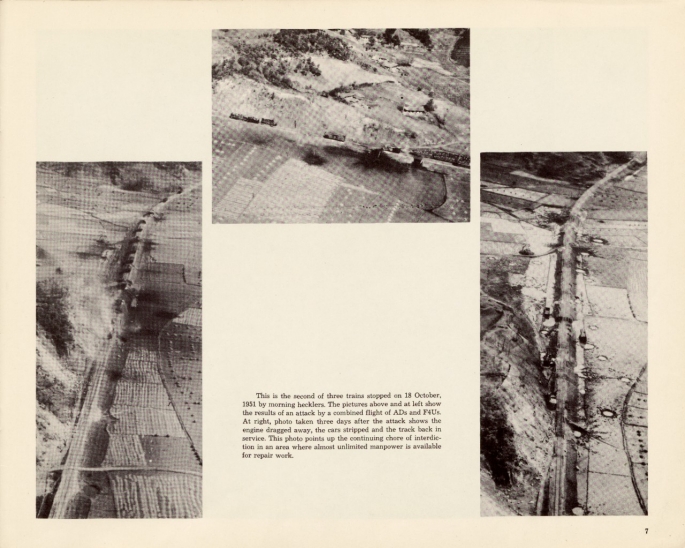
This is the second of three trains stopped on 18 October, 1951 by morning hecklers. The pictures above and at the left show the results of an attack by a combined flight of ADs and F4Us. At right, photo taken three days after the attack shows the engine dragged away, the cars stripped and the track back in service. This photo points up the continuing chore of interdiction in an area where almost unlimited manpower is available for repair work.
--7--
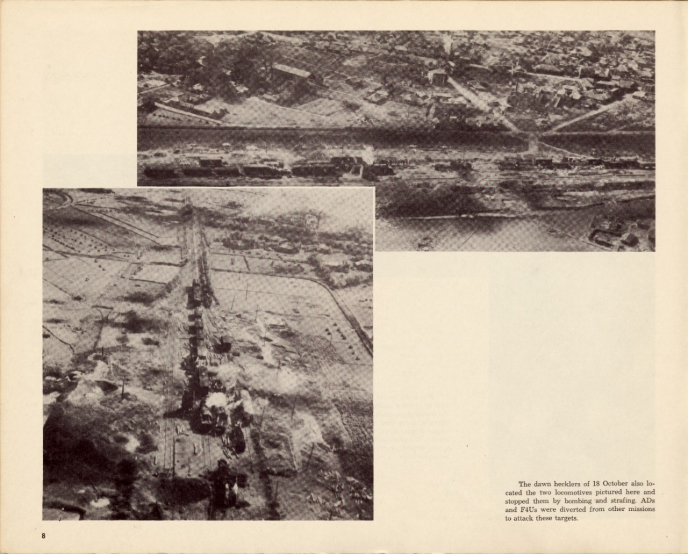
The dawn hecklers of 18 October also located the two locomotives pictured here and stopped them by bombing and strafing. ADs and F4Us were diverted from other missions to attack these targets.
--8--
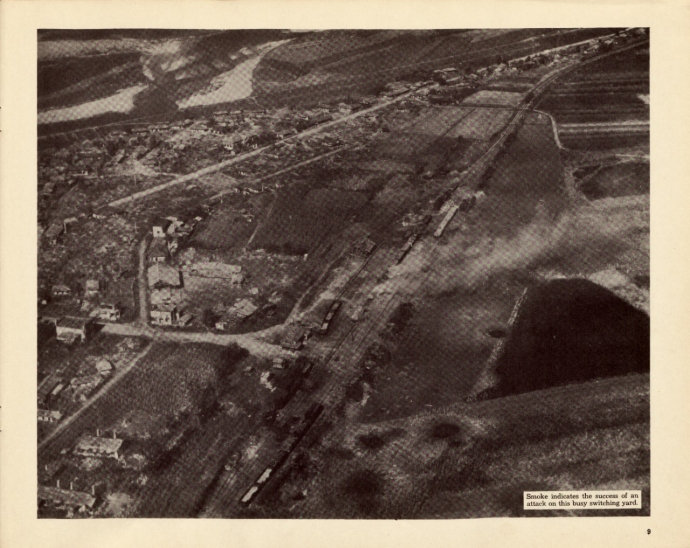
Smoke indicates the success of an attack on this busy switching yard.
--9--
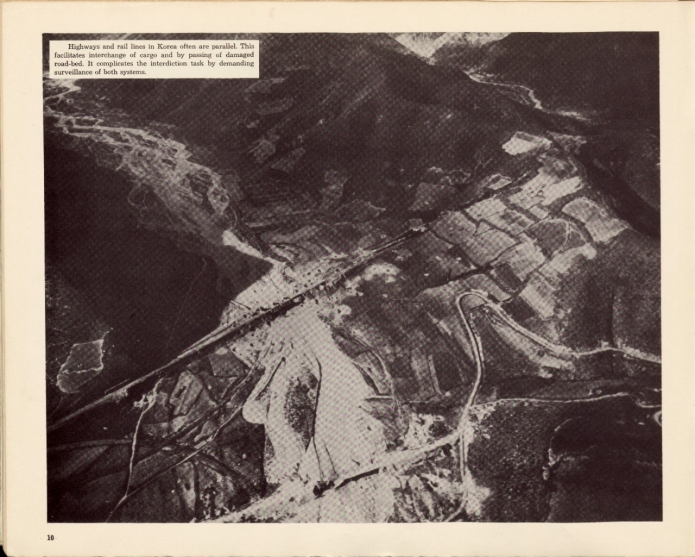
Highways and rail lines in Korea often are parallel. This facilitates interchange of cargo and by passing of damaged road-bed. It complicates the interdiction task by demanding surveillance of both systems.
--10--
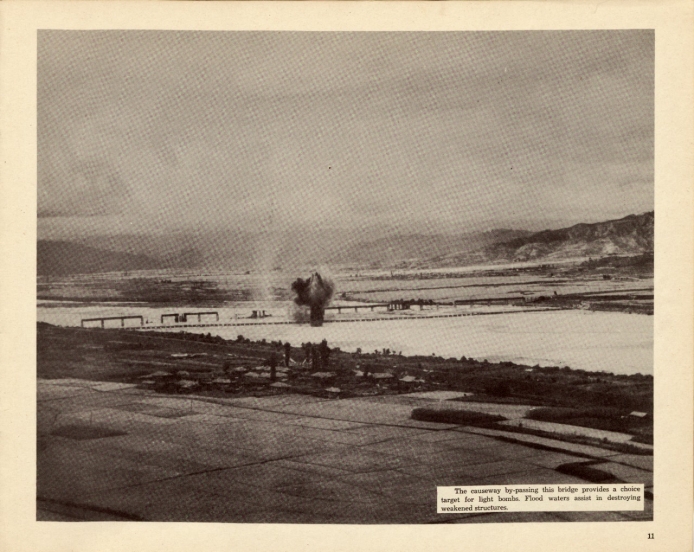
The causeway by-passing this bridge provides a choice target for light bombs. Flood waters assist in destroying weakened structures.
--11--
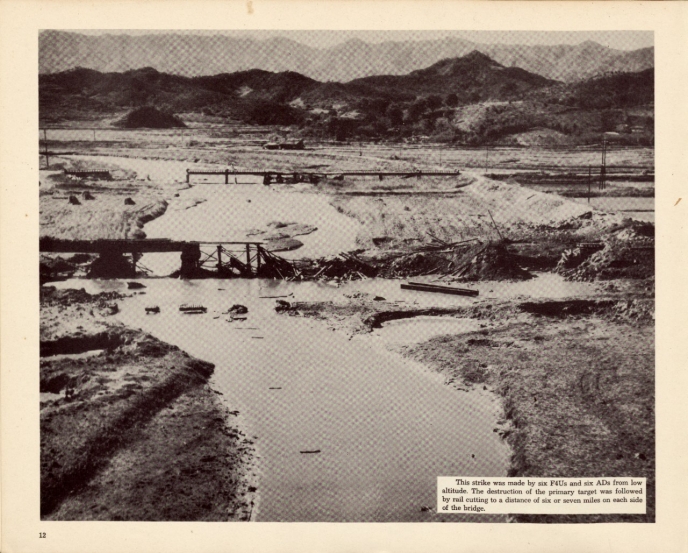
This strike was made by six F4Us and six ADs from low altitude. The destruction of the primary target was followed by rail cutting to a distance of six or seven miles on each side of the bridge.
--12--
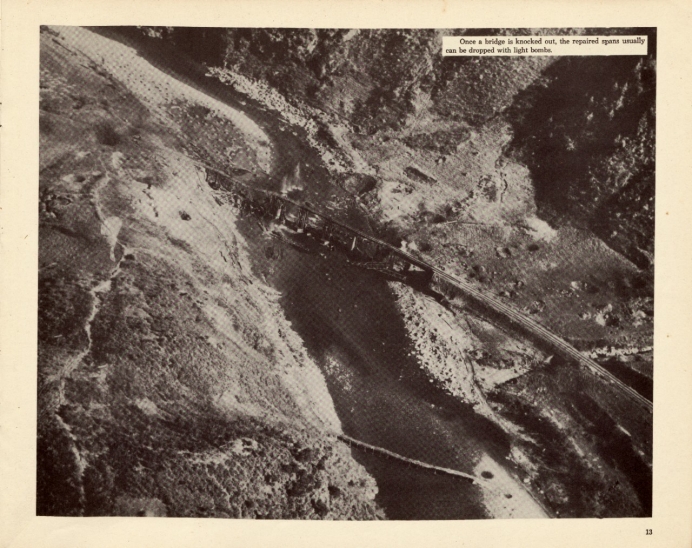
Once a bridge is knocked out, the repaired spans usually can be dropped with light bombs.
--13--
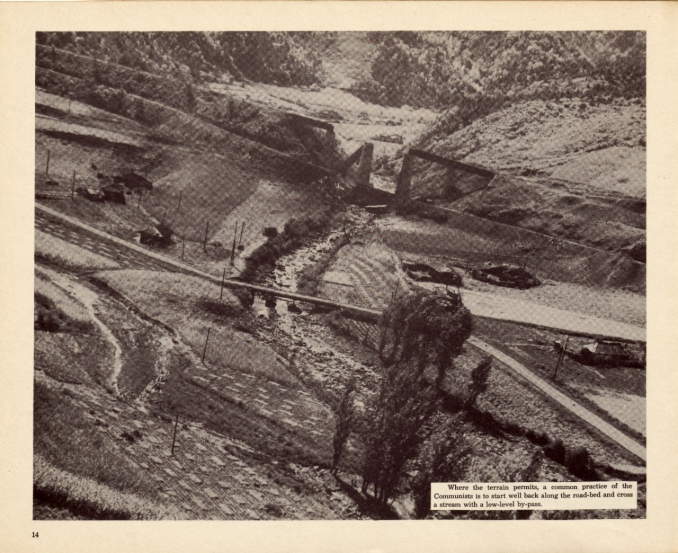
Where the terrain permits, a common practice of the Communists is to start well back along the road-bed and cross a stream with low-level by-pass.
--14--
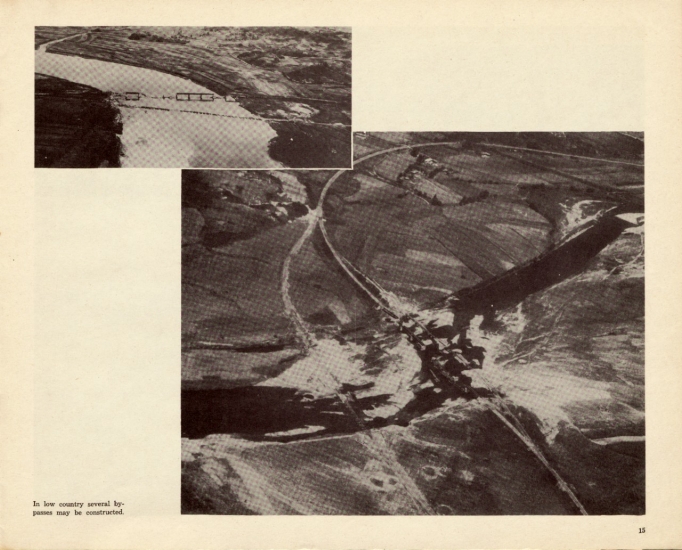
In low country several by-passes may be constructed.
--15--
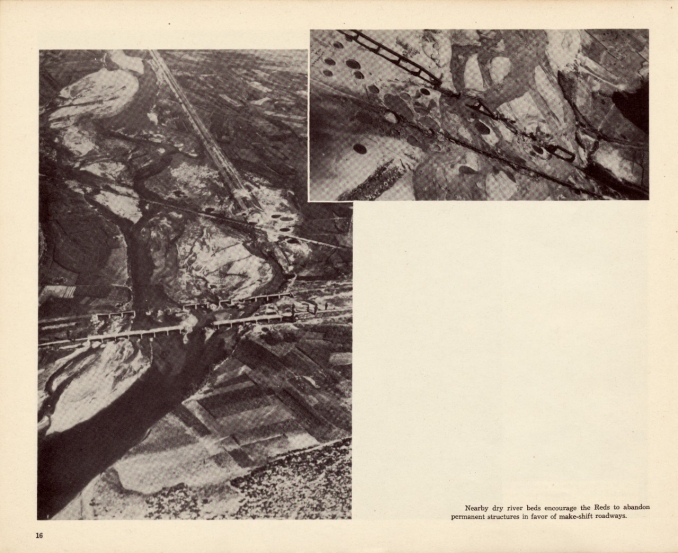
Nearby dry river beds encourage the Reds to abandon permanent structures in favor of make-shift roadways.
--16--
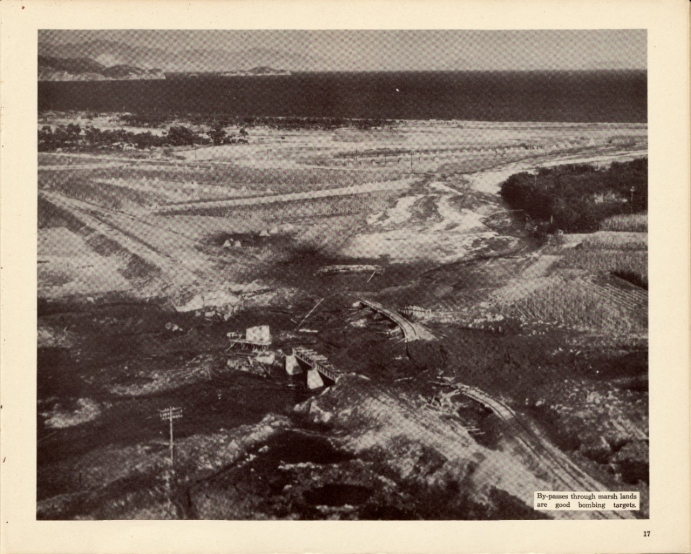
By-passes through marsh lands are good bombing targets.
--17--
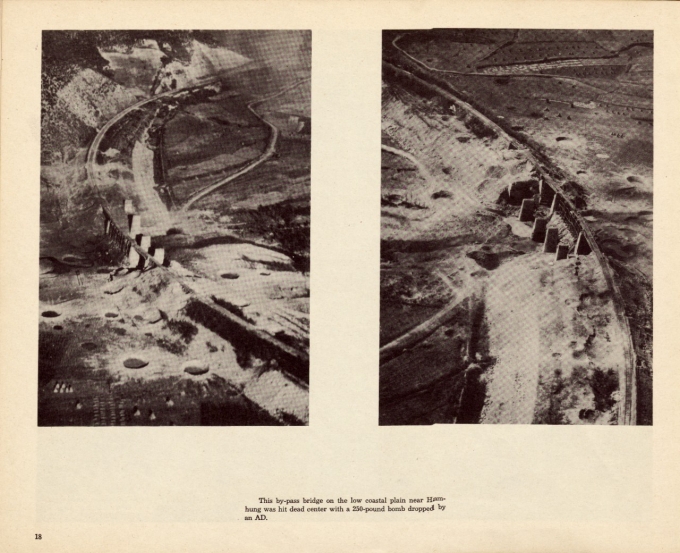
This by-pass bridge on the low coastal plain near Hamhung was hit dead center with a 250-pound bomb dropped by an AD.
--18--
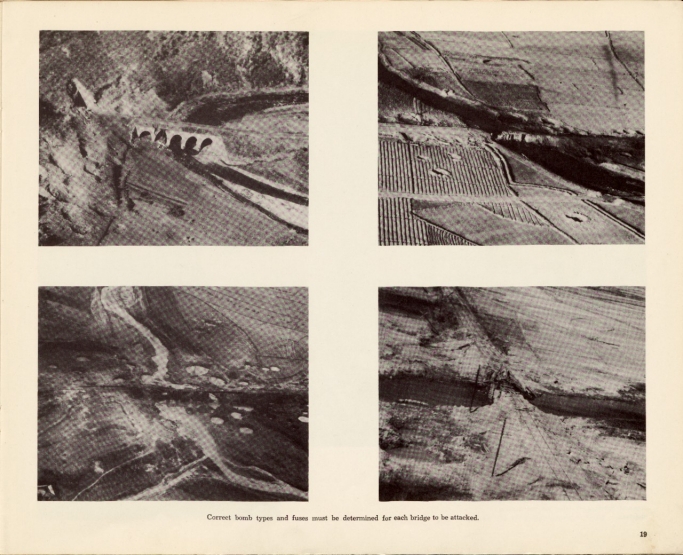
Correct bomb types and fuses must be determined for each bridge to be attacked.
--19--
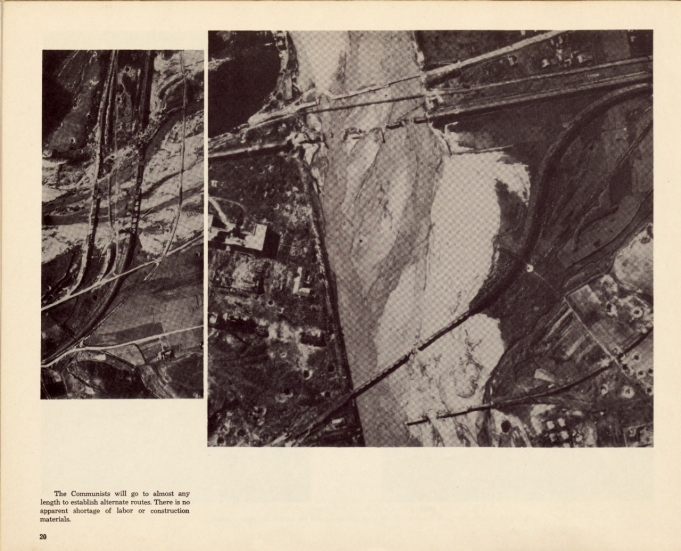
The Communists will go to almost any length to establish alternate routes. There is no apparent shortage of labor or construction materials.
--20--
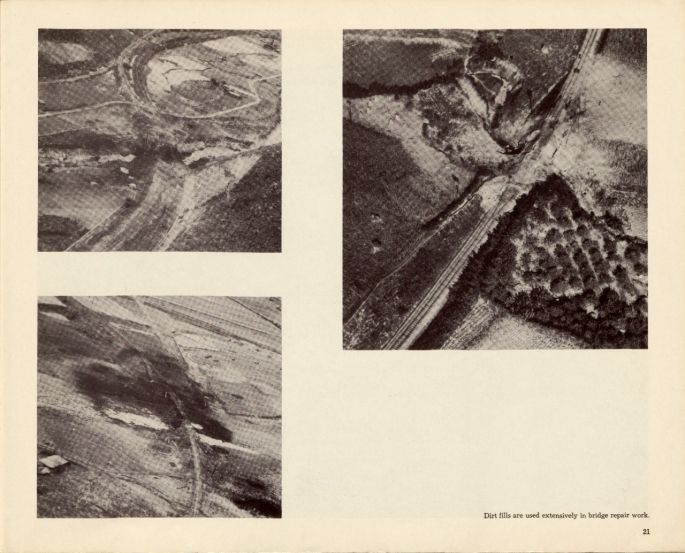
Dirt fills are used extensively in the bridge repair work.
--21--
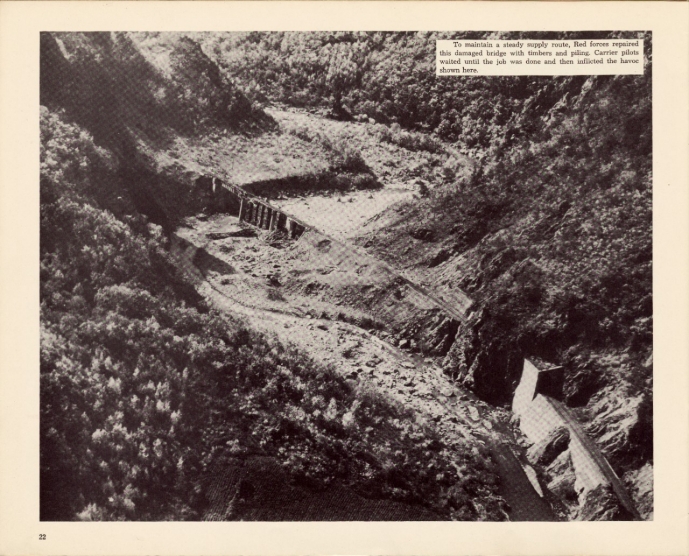
To maintain a steady supply route, Red forces repaired this damaged bridge with timbers and piling. Carrier pilots waited until they job was done and then inflicted the havoc shown here.
--22--
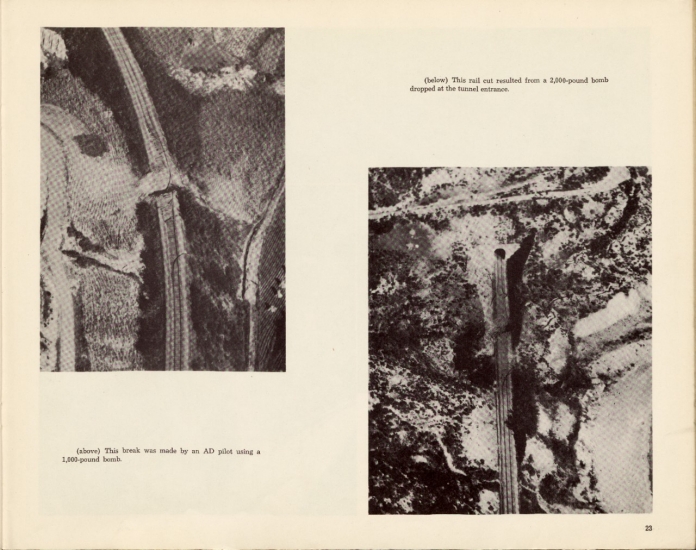
(above) This break was made by an AD pilot using a 1,000-poind bomb.
(below) This rail cut resulted from a 2,000-pound bomb dropped at the tunnel entrance.
--23--
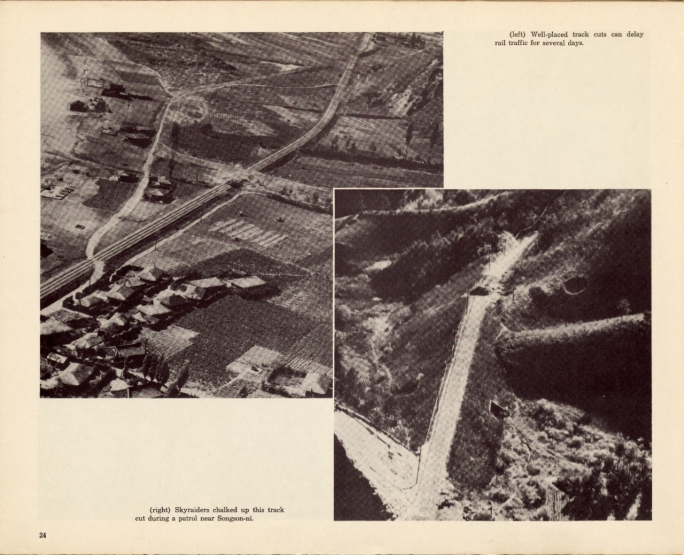
(right) Skydrive chalked up this track cut during a patrol near Songson-ni.
(left) Well-placed track cuts can delay rail traffic for several days.
--24--
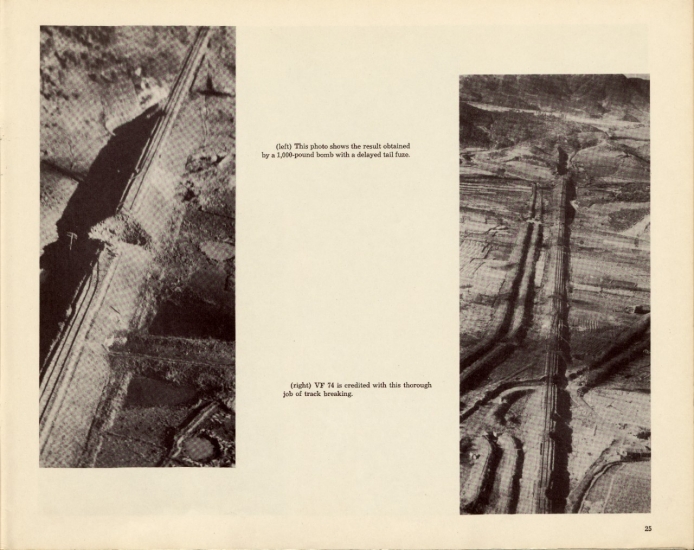
(left) This photo shows the result obtained by a 1,000-pound bomb with a delayed tail fuze.
(right) VF 74 is credited with this thorough job of track breaking.
--25--
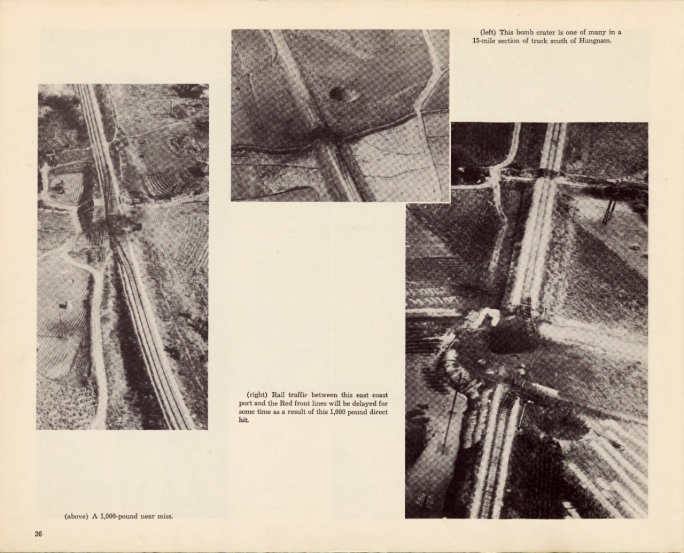
(right) Rail traffic between this east coast port and the Red front lines will be delayed for some time as a result of this 1,000 pound direct hit.
(left) This bomb crater is one of the many in a 15-mile section of track south of Hungnam.
--26--
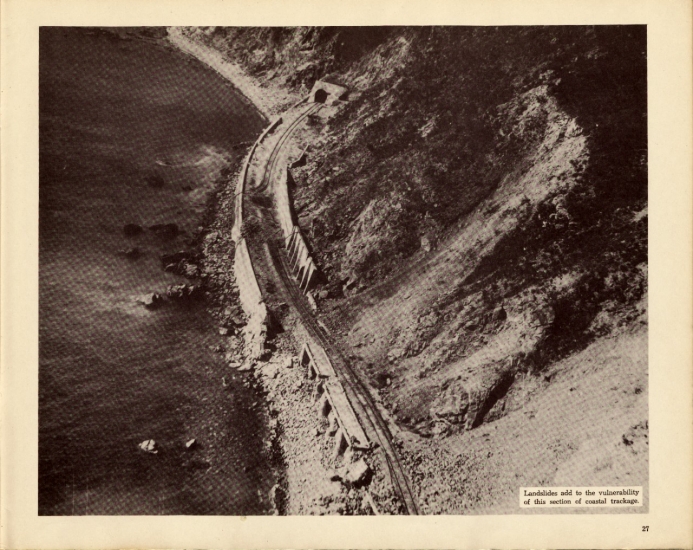
Landslides add to the vulnerability of this section of coastal trackage.
--27--
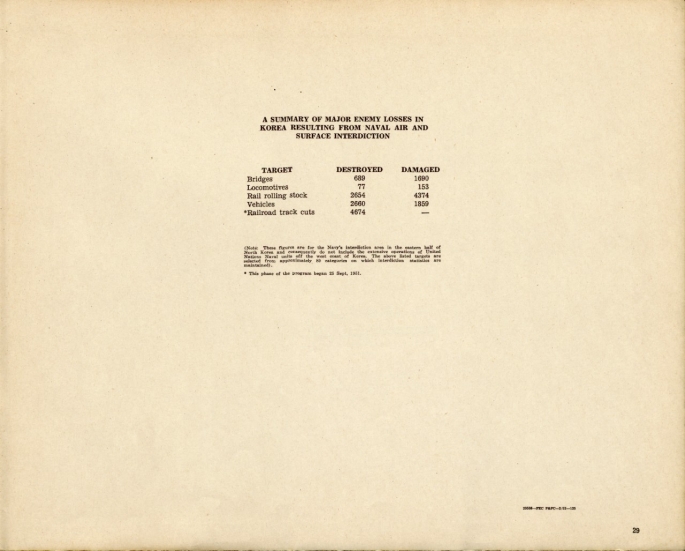
A Summary of Major Enemy Losses in Korea Resulting from Naval Air and Surface Interdiction
Target |
Destroyed |
Damaged |
Bridges |
689 |
1690 |
Locomotives |
77 |
153 |
Rail rolling stock |
2654 |
4374 |
Vehicles |
2660 |
1859 |
*Railroad track cuts |
4674 |
- |
(Note: These figures are for Navy’s interdiction area in the eastern half of North Korea and consequently do not include the extensive operations of United Nations Naval units off the west coast of Korea. The above listed targets are selected from approximately 80 categories on which interdiction statistics are maintained).
* This phase of the program began 25 Sept, 1951.
--29--
[END]

